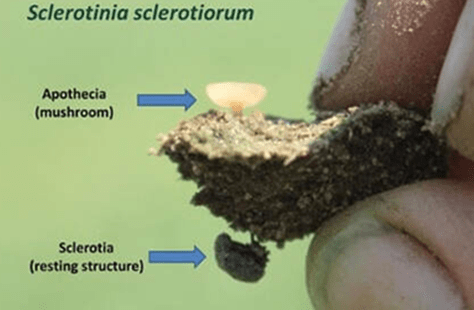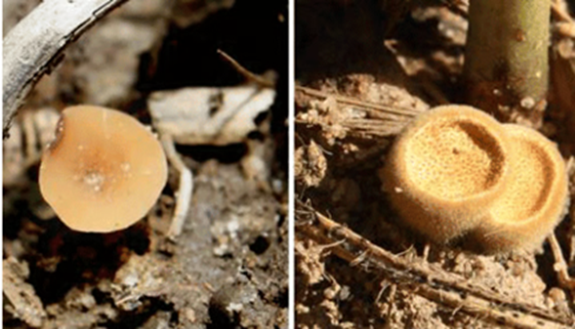White Mold Scouting
BY Dairyland Seed Agronomy Team
The weather we receive during the end of June and through July will have a large impact on the risk of white mold development. Conditions that usually create a white mold year are temperatures below 85°F and precipitation or high humidity around the time of flowering. Recent rains and increased levels of humidity in some areas have created favorable conditions for white mold. In order to have white mold, we need favorable conditions, a susceptible host, and the pathogen present.
The white mold fungus, Sclerotinia sclerotiorum, survives in the soil as sclerotia then germinates (Figure 1) to produce mushrooms (apothecia). The apothecia then release infective spores that primarily infect the soybeans through senescing flowers around the R1-R3 (first flower – beginning pod) stage. White mold symptoms don’t usually appear until the R4-R6 (full pod – full seed) growth stages. Once white mold symptoms are apparent, fungicides will not be effective.

Figure 1: White Mold Structures. Photo by Marty Chilvers, Michigan State University
Begin looking for the mushrooms (Apothecia) in fields with a higher risk for white mold. This includes any fields with a history of white mold, higher productivity, high plant populations, narrow rows, or fields with a highly susceptible soybean variety. There are other fungal species that produce mushrooms which can be easily confused with the white mold mushroom. Figure 2 shows the white mold mushroom next to the common bird’s nest mushroom. The bird’s nest mushroom is harmless and commonly mistaken for the white mold mushroom.

Figure 2: White mold mushroom (Apothecia) on the left and the common bird's nest mushroom on the right. Photo by Marty Chilvers, Michigan State University
After scouting and evaluating your risk for white mold, it might be time to consider a fungicide application. The most common way to assess your risk of developing white mold is to use a modeling tool like Sporecaster. Sporecaster is a free phone application that combines field information with research-based models to predict the best time for white mold treatment. If there is a risk factor above 40 percent during flowering, then a fungicide application should be considered. If you decide to apply a fungicide, there are several options that are considered “good.” Some examples are Approach®, Endura® and Propulse®. Other options can be found on the Fungicide Efficacy Chart from Crop Protection Network at https://cropprotectionnetwork.s3.amazonaws.com/CPN1019_FungicideEfficacyControlSoybean_final2.pdf.
If you have any additional questions, please contact your Dairyland Seed Regional Agronomist.

Brian Weller
Western Region
507.456.3034

Rod Moran
Western Region
507.456.3034

Dan Ritter
Central Region
219.863.0583

Branden Furseth
Northern Region
608.513.4265

Mark Gibson
Eastern Region
260.330.8968

Amanda Goffnett
Eastern Region
989.400.3793

Ryan Mueller
Eastern Region
989.400.3793
